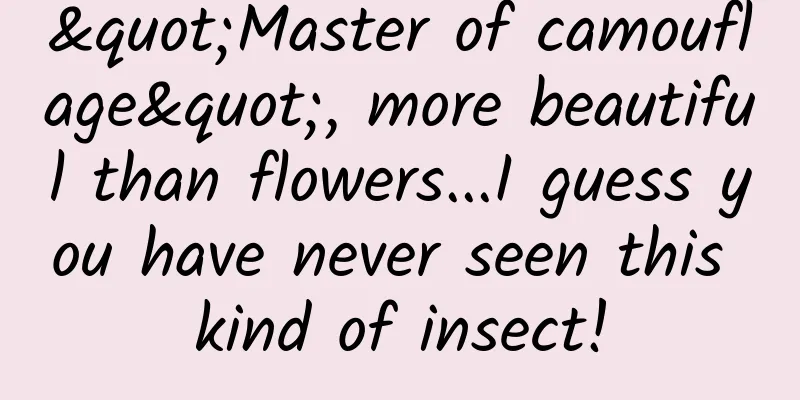"Master of camouflage", more beautiful than flowers...I guess you have never seen this kind of insect!

|
Travel writer James Hingston wrote in his 1879 travelogue: "My kind owner showed me around his garden and showed me a flower, a red orchid, which feeds on catching live flies. While I was there, it caught a butterfly and wrapped it in its beautiful but deadly leaves, just as a spider would wrap its prey in its web." Yes, this travelogue does not describe a carnivorous orchid, but a beautiful and magical insect - the orchid mantis (Hymenopus coronatus). In fact, it has been more than 100 years since people discovered orchid mantises, and the famous naturalist Wallace was once amazed by their extraordinary appearance. Orchid mantis. Image credit: Flickr/Frupus Copyright image, no permission to reprint For a long time, people believed that orchid mantises imitated orchids. They hid in orchids, waiting for an opportunity to catch prey, but some studies have shown that the "truth" in our eyes may not be correct. 01 The "Orchid Mantis" in the Human Eye Unlike most mantises, which are monotonous green or brown in appearance, the orchid mantis has a white and pink appearance . The upper part of their legs is very flat and looks like petals. If you put it in a flower, if you don't look closely, it's hard to tell that it's an insect. The orchid mantis is hiding in the flowers. Find it. Where is it? Image source: Wikipedia On the surface, the orchid mantis should be a perfect example of evolutionary biology. The mantis has evolved to mimic flowers as a way to conceal itself, hiding among the petals and feeding on insects that are attracted to the flowers. In fact, it's not just the orchid mantis. Scientists believe that members of the family Crab Spider are also good at this type of mimicry , hunting by hiding in flowers. A species of the spider family, the three-pronged flower spider, hiding in the flowers. Image source: References But when we take a closer look at the differences between the orchid mantis and the three-tipped flower spider, we will be surprised to find that, unlike the crab spider that always hides in flowers, the orchid mantis does not hide in orchids most of the time. They do not deliberately hide themselves , although their appearance is indeed the same as that of orchids. Could it be that what we have been thinking all along is wrong? Perhaps that is the answer. 02 In the eyes of insects, Orchid mantises resemble flowers, but not necessarily orchids To know the answers to the above questions, we still have to observe and understand the habits of orchid mantises patiently and carefully. So, a group of scientists who couldn't restrain their curiosity started related work. They first tested whether orchid mantises could attract flower-seeking insects. The scientists conducted a controlled experiment in which they placed three sticks in the wild. One stick had an orchid mantis on it, one stick had a purple crane flower tied to it, and the third stick had nothing on it as a blank control. Purple crane flower. Image source: nparks.gov.sg The results were as expected: both the orchid mantis and the flowers attracted insects, while the sticks attracted almost no insects. Not only that, the orchid mantis attracted even more insects than the real flowers . Orchid mantis and the number of insects attracted to the flowers. Image source: References When they compared the mantis's shape and color to real flowers from the insect's perspective, the scientists found that the orchid mantis did not look like an orchid or any specific type of flower to the insect, but rather a flower "in a broad sense." Scientists simulated the similarities and differences in visual perception between the orchid mantis and 13 kinds of wild flowers under two different Hymenoptera three-color vision models. In fact, to put it bluntly, the visual systems of insects and humans are different . If you want to know what the orchid mantis looks like in the eyes of its prey, you have to imitate the insect's visual system to observe the mantis, that is, to establish different visual models. The results suggest that orchid mantises may be closer to the average state of these flowers in the eyes of Hymenoptera insects. Similarities and differences between orchid mantises and flowers under two different hymenopteran trichromatic vision models. Image source: References In fact, insects do not recognize flowers by considering the color, fragrance, taste, shape and other aspects of flowers like humans do , but may only rely on certain key features of flowers . Orchid mantises take advantage of this. They may not be accurately imitating a specific flower, but grasping the key features of flowers to make themselves look like flowers in the eyes of most insects. Furthermore, the researchers placed plastic models of orchid mantises in the wild to compare which aspect of the mantis, its color or shape, played a more important role in attracting insects. The results showed that color was more important . Orchid mantis and plastic model. Image source: References In addition, scientists have found that praying mantises do not choose to hide in flowers most of the time. Instead, they often choose to stay with leaves. However, hiding near flowers does have benefits because insects are attracted to places near flowers. 03 Don't jump to conclusions Because we are not insects As humans with highly developed brains, although the orchid mantis's mimicry is very realistic, after a few seconds of careful inspection, we will find that this beautiful "orchid" is very suspicious. Once we find the mantis's eyes and its blurred outline, the game is over: the brain will tell us that it is a mantis, not a flower. But insects don't have developed brains like humans, and limited brain space makes their cognitive abilities extremely limited. However, insects have their own way: anything that matches a certain color is a flower containing nectar . Therefore, the orchid mantis wins, the insects are attracted to it and become its food. Orchid mantis and orchid. Image source: theconversation The orchid mantis may not be the most convincing disguiser among insects, but some of nature's best mimics are often imperfect. References: [1] O'Hanlon, JC, Holwell, GI, & Herberstein, ME (2014). Pollinator deception in the orchid mantis. The American Naturalist, 183(1), 126-132. [2] O'Hanlon, JC, Herberstein, ME, & Holwell, GI (2015). Habitat selection in a deceptive predator: maximizing resource availability and signal efficacy. Behavioral Ecology, 26(1), 194-199. [3] O'Hanlon, JC (2014). The Roles of Color and Shape in Pollinator Deception in the Orchid Mantis H ymenopus coronatus. Ethology, 120(7), 652-661. [4] Su, Q., Qi, L., Yun, Y., Zhang, W., & Peng, Y. (2020). Visual preference of flower-visiting crab spiders (Ebrechtella tricuspidata) for host flowers. Ecological Entomology, 45(3), 626-634. Produced by | Science Popularization China Author: EVEE School of Life Sciences, Peking University Producer|China Science Expo Submitted by: Computer Information Network Center, Chinese Academy of Sciences |
Recommend
2 years, 500 million users, the operating secrets of Wi-Fi Master Key
The Internet industry emphasizes speed and iterat...
Do you feel that the channels are deceptive when promoting? See what the students in the channel say
As an operator who has worked in the mainstream i...
Pistol shrimp is the key to nuclear fusion? British company imitates the shock wave of pistol shrimp attack to achieve fusion breakthrough
The development and progress of mankind is essent...
Using Didi Tickets to Talk About Product Demand, Experience, and Self-propagation
On August 9, Didi launched an innovative product ...
Increase followers, promotion, IP building, and Weibo operation skills!
Weibo is a social networking platform with great ...
Apple has selected 6 apps worth recommending in 2018. How many of them have you played?
The end of the year is approaching. Do you still ...
China Automobile Dealers Association: my country's automobile dealer inventory warning index in May 2020
As the domestic anti-epidemic situation gradually...
Re/code editor tries out iOS 9: Upgrading is not recommended at this time
Apple recently released a beta version of iOS 9 a...
How to overcome height anxiety? You don’t really need to rely on height-increasing injections →
Everyone wants to have long legs and be tall, but...
Guangdiantong advertising strategy!
Advertising Placement 1.QQ, Tencent Information S...
Don't be greedy with summer fruits, or you may pay a heavy price! See the correct way to eat fruits
It is said that summer is full of fruit flavor. E...
How to name a brand, here are 6 tips!
Written at the beginning: The success of big bran...
Android Data Binding User Guide
1. Introduction This article introduces how to us...
Yinchuan SEO Training: How to increase the speed of website index update?
Building a website and adding new pages can bring...
Jingdong Love Story
[[125843]] In recent days, rumors of the breakup ...









![Gentle White is Not White · Douyin 0-cost project: single-day income of 500, no work release, no account maintenance [video course]](/upload/images/67cc2821117aa.webp)